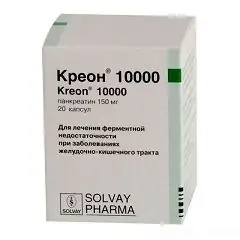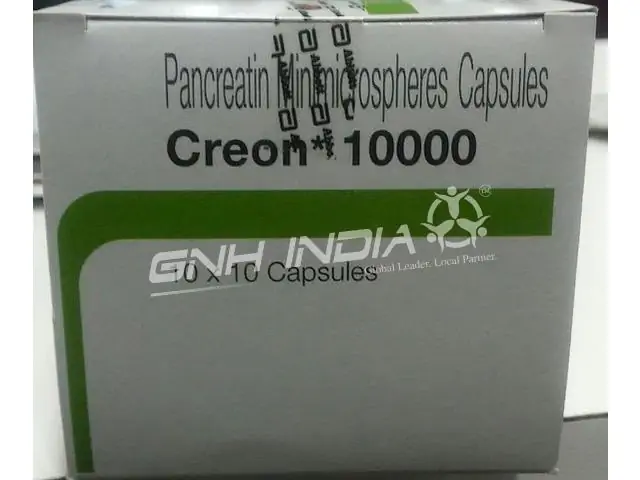- Author Rachel Wainwright [email protected].
- Public 2023-12-15 07:39.
- Last modified 2025-11-02 20:14.
Creon 10000
Creon 10000: instructions for use and reviews
- 1. Release form and composition
- 2. Pharmacological properties
- 3. Indications for use
- 4. Contraindications
- 5. Method of application and dosage
- 6. Side effects
- 7. Overdose
- 8. Special instructions
- 9. Application during pregnancy and lactation
- 10. Use in childhood
- 11. Drug interactions
- 12. Analogs
- 13. Terms and conditions of storage
- 14. Terms of dispensing from pharmacies
- 15. Reviews
- 16. Price in pharmacies
Latin name: Kreon 10000
ATX code: A09AA02
Active ingredient: Pancreatin (Pancreatin)
Manufacturer: Solvay Pharmaceuticals, Germany
Description and photo update: 2018-22-10
Prices in pharmacies: from 245 rubles.
Buy

Creon 10000 is a digestive enzyme agent.
Release form and composition
Dosage form of Creon 10000 - enteric capsules: size No. 2, gelatinous, solid, with a brown opaque lid and a colorless transparent body; contents - light brown minimicrospheres (20, 50 and 100 pcs. in polyethylene bottles with screw cap and first opening control, 1 bottle in a cardboard box).
The active substance of the drug: pancreatin, in 1 capsule - 150 mg, which corresponds to the content:
- lipase - 10,000 units of measurement of the European Pharmacopoeia (UNIT Eur. F.);
- amylase - 8000 UNITS Eur. F.;
- protease - 600 units Eur. F.
Additional components (their content in 1 capsule):
- excipients: hypromellose phthalate (56.34 mg), macrogol 4000 (37.5 mg), triethyl citrate (3.13 mg), dimethicone 1000 (1.35 mg), cetyl alcohol (1.18 mg);
- composition of the capsule shell: gelatin (60.44 mg), sodium lauryl sulfate (0.12 mg), titanium dioxide (E 171) (0.07 mg), as well as iron dyes yellow oxide (E 172) (0.05 mg), iron oxide red (E 172) (0.23 mg) and iron oxide black (E 172) (0.09 mg).
Pharmacological properties
Pharmacodynamics
Pancreatin is an enzyme substance that improves the digestion of food, which significantly reduces the symptoms of pancreatic enzyme deficiency, such as flatulence, abdominal pain, changes in the consistency and frequency of stools. Pancreatic enzymes facilitate the digestion of fats, carbohydrates and proteins so that they are completely absorbed in the small intestine.
The composition of Creon 10000 contains pork pancreatin in the form of minimicrospheres, coated with an enteric (i.e., acid-resistant) shell, in gelatin capsules. Once in the stomach, the capsules quickly dissolve, releasing hundreds of minimicrospheres. This dosage form is specially designed so that the minimicrospheres are simultaneously thoroughly mixed with the intestinal contents and transported with food from the stomach to the intestines, i.e., so that the enzymes are better distributed after release.
As soon as the minimicrospheres reach the small intestine, the capsular membrane is rapidly destroyed (at a pH of more than 5.5), enzymes with proteolytic, lipolytic and amylolytic activity are released, as a result of which proteins, fats and carbohydrates are broken down. The substances obtained as a result of cleavage are absorbed directly or undergo further digestion by intestinal enzymes.
Pharmacokinetics
In the course of studies on animals, it was found that there is no absorption of uncleaved enzymes, therefore, classical pharmacokinetic studies were not carried out.
To exert their effects, preparations containing pancreatic enzymes do not require absorption. On the contrary, their therapeutic activity is fully realized in the lumen of the gastrointestinal tract.
By their chemical structure, enzymes are proteins, and therefore, when passing through the gastrointestinal tract, they are cleaved until they are absorbed in the form of amino acids and peptides.
Indications for use
Creon 10000 is used for replacement therapy of enzymatic (exocrine) pancreatic insufficiency due to a decrease in its enzymatic activity due to impaired production, regulation of secretion and delivery of pancreatic enzymes or due to their increased destruction in the intestinal lumen caused by various diseases of the gastrointestinal tract (GIT) …
Most often, Creon 10000 is prescribed in the following cases:
- conditions after an attack of acute pancreatitis;
- chronic pancreatitis;
- cystic fibrosis;
- Schwachman-Diamond syndrome;
- partial gastric resection (for example, Billroth II);
- obstruction of the pancreatic duct or common bile duct (for example, due to a neoplasm);
- pancreas cancer;
- conditions after surgery on the pancreas;
- conditions after extirpation (gastrectomy) of the stomach;
- preparation for ultrasound or X-ray examination of the abdominal organs.
For patients with normal gastrointestinal tract function, the drug is recommended in case of errors in nutrition, impaired chewing function, a sedentary lifestyle or forced prolonged immobilization.
Contraindications
The use of Creon 10000 is contraindicated in case of hypersensitivity to its components.
You should not take the drug for an acute attack of pancreatitis.
Instructions for the use of Creon 10000: method and dosage
The capsules are taken orally with meals or immediately after each meal, including light snacks. They must be swallowed whole and washed down with plenty of liquid. For patients with difficulty swallowing and children, capsules can be carefully opened and the minimicrospheres contained in them can be added to soft foods that do not require chewing and have a sour taste, or taken with a liquid with a sour taste. Foods that can be mixed include: applesauce, yoghurt, fruit juices (apple, pineapple and orange) with a pH <5.5. Such mixtures cannot be stored, so they should be used immediately after preparation. Do not mix the contents of the capsules with hot food.
The dose of Creon 10,000 (in terms of lipase) is selected individually, taking into account the type of violation, the severity of the disease, the composition of the diet and the patient's body weight.
For cystic fibrosis, at the beginning of treatment, adults and children from 4 years old are prescribed 500 U / kg, children under 4 years old - 1000 U / kg with each meal. Depending on the severity of the symptoms of the disease, the results of control of steatorrhea and individual sensitivity, the dose can be adjusted. For most patients, the daily dose does not exceed 10,000 U / kg of body weight or 4,000 U / g of fat consumed.
In other conditions, accompanied by enzymatic pancreatic insufficiency, the dose is determined depending on the individual characteristics of the patient, including the degree of indigestion and fat content in the diet. With the main meal, a dose of 25,000-80,000 U of lipase is usually required, with snacks - ½ of the therapeutic dose.
For children, Creon 10,000 is used only as directed by a doctor.
Side effects
- from the digestive system *: very often (≥ 1/10) - pain in the abdomen; often (≥ 1/100 to <1/10) - bloating, constipation or diarrhea, nausea, vomiting; frequency unknown - strictures of the cecum, colon and ileum (fibrosing colonopathy);
- on the part of the skin and subcutaneous tissues: infrequently (from ≥ 1/1000 to <1/100) - rash; frequency unknown - urticaria, itching;
- from the immune system **: frequency unknown - hypersensitivity reactions (anaphylactic reactions);
- on the part of metabolism: with prolonged use of the drug in high doses - hyperuricosuria, in excessively high doses - an increase in the level of uric acid in the blood plasma;
- others: in children, when using the drug in high doses - perianal irritation.
* Disorders from the gastrointestinal tract are associated mainly with the underlying disease. The incidence of diarrhea and abdominal pain is similar or lower than with placebo. Fibrosing colonopathy has been observed in patients with cystic fibrosis treated with high doses of pancreatin.
** Allergic reactions occurred more often from the skin, but other manifestations of allergy were also observed.
Overdose
An overdose of pancreatin can manifest as hyperuricosuria and hyperuricemia. In this case, the drug is canceled and symptomatic therapy is carried out.
special instructions
As a result of chewing and crushing minimicrospheres or mixing them with food / drinks with a pH of more than 5.5, their protective enteric coating may be destroyed and, as a consequence, early release of enzymes in the oral cavity, irritation of the mucous membranes and a decrease in the effectiveness of pancreatin. Therefore, when using minimicrospheres without a capsule shell, it is necessary to make sure that they are all swallowed and nothing remains in the mouth.
During treatment, it is important to ensure that there is sufficient fluid intake at all times, especially if fluid loss is increased. Constipation can occur or worsen due to inadequate fluid intake.
Creon 10000 is not recommended to be taken in the acute phase of chronic pancreatitis.
Patients with cystic fibrosis receiving high doses of pancreatin are at risk of developing fibrosing colonopathy. Therefore, the dose should be adequate to the amount of enzymes required for the absorption of fat, taking into account the quantity and quality of food in the diet, and, if possible, should not exceed 10,000 U / kg per day (in terms of lipase). If unusual symptoms or changes in the abdominal cavity appear, a medical examination is indicated, especially in patients taking Creon 10000 in daily doses of more than 10000 U / kg.
Disorders from the digestive system can occur in patients with individual hypersensitivity to pancreatin, patients with meconium ileus and a history of bowel resection.
Influence on the ability to drive vehicles and complex mechanisms
According to the instructions, Creon 10000 does not have a significant negative effect on the ability to work with complex mechanisms, drive a car and perform work that requires attention and speed of reactions.
Application during pregnancy and lactation
In animal studies, no toxic effects on reproductive function and fetal development have been identified, however, there is no clinical data on the treatment of pregnant women with drugs containing porcine pancreatic enzymes, therefore, the drug is prescribed to them with caution if the expected benefits outweigh the potential risks.
Considering the results of animal studies, in which the negative effect of pancreatic enzymes has not been identified, the harmful effects of Creon 1000 on an infant through mother's milk are also not expected. In this regard, the drug can be taken during lactation.
Both pregnant and breastfeeding women are advised to take the drug in moderate doses, sufficient to maintain adequate nutritional status.
Pediatric use
The use of Creon 10000 in childhood is possible according to the recommended dosage regimen.
In children, the risk of constipation increases with high activity of lipase contained in pancreatin, so the dose should be increased gradually.
Drug interactions
Studies on the interaction of pancreatin have not been conducted.
Pancreatin can reduce the absorption of concomitantly used iron preparations. May theoretically reduce the clinical efficacy of acarbose.
Antacids containing magnesium hydroxide and / or calcium carbonate can reduce the effectiveness of pancreatin.
Analogs
The analogues of Creon 10000 are: Gastenorm forte, Gastenorm forte 10000, Creon 25000, Creon 40,000, Creon Micro, Mezim 20000, Mezim forte, Mezim forte 10000, Micrasim, Pangrol 25000, PanziKam, Panzim forte, Pancreasim, Pancreatin, Pancreatin forte, LekT, Penzital, Enzistal-P, Hermital.
Terms and conditions of storage
Store in a tightly closed bottle, out of the reach of children with temperatures up to 25 ° C.
Shelf life - 2 years, after the first opening of the bottle - 3 months.
Terms of dispensing from pharmacies
Available without a prescription.
Reviews about Creon 10000
Many doctors prescribe Creon 10000 for the treatment of enzymatic insufficiency of the pancreas in children, since they argue that only symptomatic treatment (the use of ointments and antihistamines) is not enough. According to the results of scatology, after taking the course, the amount of undigested food is significantly reduced, the quality of the stool improves, and outwardly the skin becomes noticeably cleaner.
Reviews of Creon 10,000 from patients in most cases are positive: they note a significant improvement in their condition after a few days of treatment, write that digestion and stool are normalized, pains, discomfort in the gastrointestinal tract and in the side, nausea after eating, including number in children. Some use it themselves and advise others to use this drug as a first aid for nutritional errors, especially when traveling - when changing cuisine and time zones.
Despite the fact that there are many analogues of this drug, including an order of magnitude cheaper, many do not recommend replacing Creon 10,000 on their own, since they consider the analogues to be insufficiently high-quality and effective.
It is worth mentioning that there are also some negative reviews about Creon 10,000 from patients in whom it caused side effects (more often - abdominal pain and nausea).
Price for Creon 10000 in pharmacies
In the pharmacy chain, the price for Creon 10,000 varies from 235 to 320 rubles for a pack of 20 capsules.
Creon 10000: prices in online pharmacies
|
Drug name Price Pharmacy |
|
Creon 10,000 10,000 IU enteric capsules 20 pcs. 245 RUB Buy |
|
Creon 10000 caps. ksh / solution 150mg n20 313 r Buy |
|
Creon 10,000 10,000 IU enteric capsules 50 pcs. RUB 500 Buy |
|
Creon 10,000 capsules enteric solution. 10000 units 50 pcs. RUB 624 Buy |

Maria Kulkes Medical journalist About the author
Education: First Moscow State Medical University named after I. M. Sechenov, specialty "General Medicine".
Information about the drug is generalized, provided for informational purposes only and does not replace the official instructions. Self-medication is hazardous to health!






